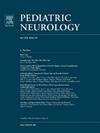Neurocognitive Evaluation of Patients With DiGeorge Syndrome
IF 3.2
3区 医学
Q2 CLINICAL NEUROLOGY
引用次数: 0
Abstract
Background
DiGeorge syndrome (DGS), the most common microdeletion syndrome, affects multiple organs, including the heart, the nervous system, and the immune system. In this study, we aimed to evaluate the clinical, laboratory, brain magnetic resonance imaging (MRI), and neurocognitive findings of our patients with DGS.
Methods
Clinical and laboratory data of 52 patients with DGS between June 2000 and March 2022 were evaluated retrospectively. Brain MRI and neuropsychologic tests were performed to assess the neurocognitive status of the patients.
Results
Fifty-two patients (28 males and 24 females) were included in our study. Fifteen of them died during the follow-up. All 37 patients who are alive had partial DGS. The median age of patients was 10 years and 7 months, and the median age at diagnosis was 5 years and 4 months. Bilateral conduction deceleration in the anterior visual pathways in six (20%) of 30 patients was determined by the visual evoked potentials. The auditory brainstem evoked potential test showed sensorineural hearing loss in 11 of 30 (36.6%) patients. Brain MRI disclosed brain parenchymal abnormalities in 18 of 25 (72%) patients. Impairments in executive functions, expressive language, and verbal memory were noted in 18 patients who were neuropsychologically assessed.
Conclusions
It is important to keep in mind that patients with DGS may be accompanied by neurocognitive findings. Awareness of the potential for underlying psychiatric and neurodevelopment disorders is key to anticipatory guidance, optimization of therapies, and maximizing life quality.
迪乔治综合征患者的神经认知评估。
背景:迪乔治综合征(DGS)是最常见的微缺失综合征,影响多个器官,包括心脏、神经系统和免疫系统。在这项研究中,我们旨在评估 DGS 患者的临床、实验室、脑磁共振成像(MRI)和神经认知结果:回顾性评估了 2000 年 6 月至 2022 年 3 月期间 52 例 DGS 患者的临床和实验室数据。结果:52 名 DGS 患者(28 名男性)的临床和实验室数据得到了回顾性评估,脑磁共振成像和神经心理学测试对患者的神经认知状况进行了评估:研究共纳入52名患者(28名男性,24名女性)。其中 15 人在随访期间死亡。37名存活的患者均患有部分DGS。患者的中位年龄为 10 岁零 7 个月,确诊时的中位年龄为 5 岁零 4 个月。根据视觉诱发电位确定,30 名患者中有 6 人(20%)的双侧视觉前通路传导减速。听觉脑干诱发电位测试显示,30 名患者中有 11 人(36.6%)出现感音神经性听力损失。脑磁共振成像显示,25 名患者中有 18 名(72%)出现脑实质异常。18名接受神经心理学评估的患者在执行功能、语言表达能力和言语记忆力方面均存在障碍:重要的是要记住,DGS 患者可能伴有神经认知结果。意识到潜在的精神和神经发育障碍是提供预期指导、优化疗法和最大限度提高生活质量的关键。
本文章由计算机程序翻译,如有差异,请以英文原文为准。
求助全文
约1分钟内获得全文
求助全文
来源期刊

Pediatric neurology
医学-临床神经学
CiteScore
4.80
自引率
2.60%
发文量
176
审稿时长
78 days
期刊介绍:
Pediatric Neurology publishes timely peer-reviewed clinical and research articles covering all aspects of the developing nervous system.
Pediatric Neurology features up-to-the-minute publication of the latest advances in the diagnosis, management, and treatment of pediatric neurologic disorders. The journal''s editor, E. Steve Roach, in conjunction with the team of Associate Editors, heads an internationally recognized editorial board, ensuring the most authoritative and extensive coverage of the field. Among the topics covered are: epilepsy, mitochondrial diseases, congenital malformations, chromosomopathies, peripheral neuropathies, perinatal and childhood stroke, cerebral palsy, as well as other diseases affecting the developing nervous system.
 求助内容:
求助内容: 应助结果提醒方式:
应助结果提醒方式:


